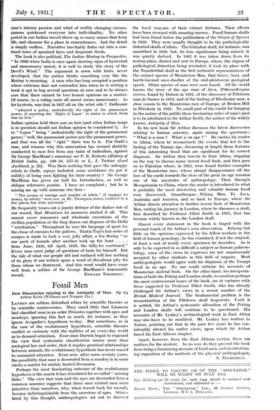Fossil Men
New Discoveries relating to the Antiquity of Man. By Sir Arthur Keith (Williams and Norgate 21s.) LAYMEN are seldom disturbed either by scientific theories or by scientific controversies. They cared little that Linnaeus had classified man in an order Primates together with apes and monkeys, ignoring this fact as much, for instance, as they ignore Avogadro's hypothesis to-day. But sometimes, as in the case of the evolutionary hypothesis, scientific theories conflict so seriously with the realities of an every-day world as to demand attention. Ever since Darwin began to expound the view that systematic classification means more than zoological law and order, that it implies genetical relationships between animals, the evolutionary hypothesis has never ceased to command attention. Even now, after some seventy years, the possibility that man is descended from a monkey is in some circles a matter for unduly heated discussion.
Perhaps the most fascinating outcome of the evolutionary hypothesis is the search it has stimulated for so-called" missing links." The view that man and the apes are descended from a common ancestor suggests that there once existed men more primitive than ourselves, who, when traced back far enough, become indistinguishable from the ancestors of apes. Stimu- lated by this thought, anthropologists set out to discover the fossil rem sins of their extinct forbears. Their efforts have been crowned with amazing success. Fossil human skulls had been found before the publication of the Origin of Species in 1859. They were usually thought to be the pathologically distorted skulls of idiots. The Gibraltar skull, for instance, was unearthed in 1848, but, its true significance being missed, it was quietly shelved. In 1862 it was taken down from its resting-place, dusted and sent to Europe, where, the stigma of pathological distortion being rescinded, it took its place with the Neanderthal skull as the first authentic representatives of the extinct species of Mousterian Man, that heavy, bent, and beetle-browed cave-dweller of the mid-pleistocene geological epoch. Other species of man were soon found. All the world knows the story of the ape man of Java, Pithecanthropus erect us, found by Dubois in 1891, of the discovery of Piltdown man in Sussex in 1912, and of the finding of Rhodesian man, a close cousin to the Mousterian race of Europe, at Broken Hill in Rhodesia in 1921. No small part of the credit for bringing to the notice of the public these fascinating relies of man's past is to be attributed to Sir Arthur Keith, the author of the widely known Antiquity of Man.
In his new book Sir Arthur discusses the latest discoveries relating to human ancestry, again raising the questions : "What is a man ? What is an ape ? " He carries his reader to Africa, where he reconstructs the events that led to the finding of the Taungs ape, discussing at length those features of this interesting fossil that are significant for its correct diagnosis. Sir Arthur then travels to East Africa, stopping on the way to discuss many recent fossil finds, and then goes on to Palestine where, in 1925, were found further examples of the Mousterian race, whose abrupt disappearance off the face of the earth towards the close of the great ice age remains one of the mysteries of anthropology. Then through Mesopotamia to China, where the reader is introduced to what is probably the most interesting and valuable human fossil ever discovered, Sinanthropus—Peking Man. To Java, Australia and America, and so back to Europe, where Sir Arthur directs attention to further recent finds of Mousterian Man, ending his journey in London, where he discusses a skull, first described by Professor Elliot Smith in 1925, that has become widely known as the London skull.
Almost every statement in the book is tinged with the personal touch of Sir Arthur's own observation. Relying but little on the opinions expressed by his fellow-workers in the field of human genealogy, he has examined, if not the original, at least a cast of nearly every specimen he describes. As is only to be expected in so difficult a subject as human palaeon- tology, some of the views he expresses are not unanimously accepted by other students in this field of enquiry. Most anthropologists would agree with his diagnosis of the Taungs fossil as an ape. No one could criticize his accounts of Mousterian skeletal finds. On the other hand, his interpreta- tions of both the Peking and London skulls, to mention perhaps the most controversial issues of the book, are at variance with those suggested by Professor Elliot Smith, who has already challenged Sir Arthur's views in a recent number of the British Medical Journal. The fundamental problem is the reconstruction of the Piltdown skull fragments. Until it is settled, Sir Arthur's systematic allocation of the Peking and London skulls will continue to be questioned. His accounts of Mr. Leakey's archaeological work in East Africa may also have to be modified. Mr. Leakey has written to Nature, pointing out that in the past few years he has con- siderably altered his earlier views, upon which Sir Arthur based his East African chapter.
Apart, however, from the East African section, these are matters for the student. In no way do they prevent the book from being a luminating account of fossil man, and an entertain- ing exposition of the methods of the physical anthropologist, S. ZUCKERMAN.










































 Previous page
Previous page